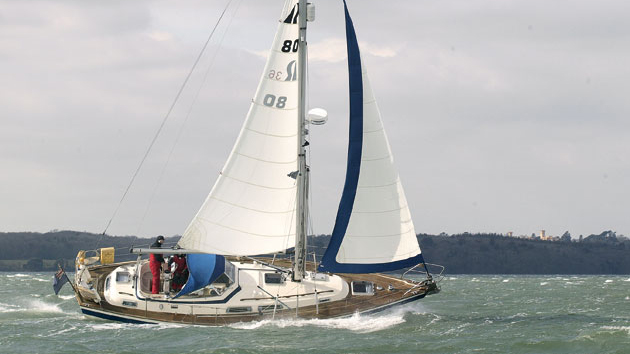Pete Goss talks in-mast furling, considers the dangers of the highly convenient reefing system when it fails and explains why it's a big 'no' for him
One of my pleasures in life is to wander round marinas nosing at what’s afloat and I’ve started to notice in-mast furling systems are becoming a lot more common.
Now I know that everything has its place and I am sure there are many delighted owners who take great pleasure in being able to watch their sail swallowed up at the touch of a button. A complex job nailed as distracted parents keep an eye on their kids. Or perhaps an elderly couple saving their knees from clambering onto the foredeck with faltering balance. No flaking or wrestling with a boom cover has to be the icing on the cake, but these benefits aside, I have to say that they make my blood run cold.
In theory modern communications, better weather information and a prudent approach should provide a lifetime of risk-free sailing, but of course life isn’t always quite that predictable. Forecasts can be wrong, decisions about putting to sea often require taking it on the chin in the short term to avoid a knockout blow later. Equipment failure, or perhaps having to offer assistance, can extend a voyage into the conditions that your perfect passage plan set out to avoid.
The bottom line is that it pays to plan for the best but be prepared for the worst and, for me, an in-mast furler just doesn’t cut it. Nor does an in-boom furler, but at least with this system you can still drop the main.
Twice I have had to help a fellow sailor wrestle with a jammed in-mast furling system whilst the boat pranced about at anchor. How one would go about tackling this at sea in a rising gale is beyond me. Do you career off downwind, barely in control, with crossed fingers that you have the sea room to ride it out? Or do you crash to windward under engine, hoping that the shredding sails don’t bring the mast down?

In-mast mainsail reefing makes it less stressful when sailing shorthanded but what happens when it goes wrong? Credit: Paul Wyeth
My preference is for a well-thought-out slab reefing system that is chafe-free and provides access to all parts of the sail whilst reefed. I remember having to repair a big tear in the bottom panel of the main during the British Steel Challenge. We simply dropped a reef in and were able to keep sailing whilst a working party either side of the sail pushed a needle back and forth.
That’s the joy of it – a slab system malfunction can be made good with a bit of imagination, some blocks and a length of rope. Sail shape is maintained through the reefs but most importantly you can reef at all points of sail, particularly whilst running off the wind.
Any system is only as good as its maintenance programme and one of the other things I have noticed is that the boats with in-mast furling are often the most neglected. It’s
all too easy for the seduction of convenience to erode good practice as the boat is parked up and left in favour of all the other priorities that come with a busy life.
Problems don’t get picked up in their infancy like they would with the more hands-on relationship that comes with a slab system. This allows minor symptoms to covertly expand into a complete system failure.
If you’re still on the fence, I would highly recommend reading the article ‘Anatomy of a tragedy’ on the Bluewater Sailing website. It’s a harrowing read that will move you to tears at the needless loss of life. As the report unfolds, it’s easy to see that Karl and Annamarie Frank were an experienced and diligent couple on a well-found boat. Lots can be learned in a number of areas but for me the fundamental issue was the limitation presented by their in-boom furler.
Enjoyed reading this?
A subscription to Yachting Monthly magazine costs around 40% less than the cover price.
Print and digital editions are available through Magazines Direct – where you can also find the latest deals.
YM is packed with information to help you get the most from your time on the water.
-
-
- Take your seamanship to the next level with tips, advice and skills from our experts
- Impartial in-depth reviews of the latest yachts and equipment
- Cruising guides to help you reach those dream destinations
-
Follow us on Facebook, Twitter and Instagram.





